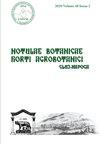土耳其安塔利亚省番茄褐皱果病毒(ToBRFV)变异的遗传多样性和群体结构
IF 1.3
4区 生物学
Q3 PLANT SCIENCES
引用次数: 0
摘要
在这项研究中,利用从土耳其安塔利亚生产温室获得的6种新型番茄褐褐果病毒(ToBRFV)变体和全球变体,根据该制剂的CP和MP基因全编码区域进行了生物信息学分析。利用CP和MP基因区进行的分子进化分析表明,所有变异分布在三个主要进化支中。种群动态研究表明,这两个基因区域的核苷酸多样性和单倍型多样性都很低。CP和MP基因的低单倍型多样性表明几乎没有重组状态。CP和MP基因区存在较强的负选择,dN/dS分别为0.0877和0.2104。中立性试验结果显示,ToBRFV种群处于扩张阶段。对在地理层次上被划分为美洲、欧洲和亚洲变体的种群进行两两比较,结果显示出强烈的基因流动和高遗传相似性(FST<0,33和迁移率>1)。这项研究的结果揭示了该病毒最近的种群结构,并建议在国际种子贸易中对受污染的种子采取必要的预防措施。本文章由计算机程序翻译,如有差异,请以英文原文为准。
Genetic diversity and population structure of tomato brown rugose fruit virus (ToBRFV) variants from Antalya province, Turkey
In this study, bioinformatic analyses were carried out according to the fully coded CP and MP gene regions of the agent, using six novel tomato brown rugose fruit virus (ToBRFV) variants obtained from the production greenhouses in Antalya, where the infection was first detected in Turkey and global variants. Molecular evolutionary analyses using both CP and MP gene regions showed that all variants were distributed in three major clades. Population dynamics studies for both gene regions have shown that there was very low nucleotide diversity and haplotype diversity. The low haplotype diversity for the CP and MP genes indicated almost no recombination status. A strong negative selection was determined for CP and MP gene regions, dN/dS= 0.0877 and dN/dS=0.2104, respectively. Neutrality test results revealed that ToBRFV populations are in an expansion phase. Pairwise comparisons were performed between populations separated in the geographic hierarchy as American, European, and Asian variants, and the findings showed intense gene flow and high genetic similarity (FST<0,33 and migration rate >1). The results of this study reveal the recent population structure of the virus and suggest that necessary precautions should be taken in the international seed trade against contaminated seeds.
求助全文
通过发布文献求助,成功后即可免费获取论文全文。
去求助
来源期刊

Notulae Botanicae Horti Agrobotanici Cluj-napoca
PLANT SCIENCES-
CiteScore
2.70
自引率
0.00%
发文量
118
审稿时长
3 months
期刊介绍:
Notulae Botanicae Horti Agrobotanici Cluj-Napoca is a peer-reviewed biannual journal aimed at disseminating significant research and original papers, critical reviews and short reviews. The subjects refer on plant biodiversity, genetics and plant breeding, development of new methodologies that can be of interest to a wide audience of plant scientists in all areas of plant biology, agriculture, horticulture and forestry. The journal encourages authors to frame their research questions and discuss their results in terms of the major questions of plant sciences, thereby maximizing the impact and value of their research, and thus in favor of spreading their studies outcome. The papers must be of potential interest to a significant number of scientists and, if specific to a local situation, must be relevant to a wide body of knowledge in life sciences. Articles should make a significant contribution to the advancement of knowledge or toward a better understanding of existing biological and agricultural concepts. An international Editorial Board advises the journal. The total content of the journal may be used for educational, non-profit purposes without regard to copyright. The distribution of the material is encouraged with the condition that the authors and the source (Notulae Botanicae Horti Agrobotanici Cluj-Napoca or JCR abbrev. title Not Bot Horti Agrobo) are mentioned.
 求助内容:
求助内容: 应助结果提醒方式:
应助结果提醒方式:


